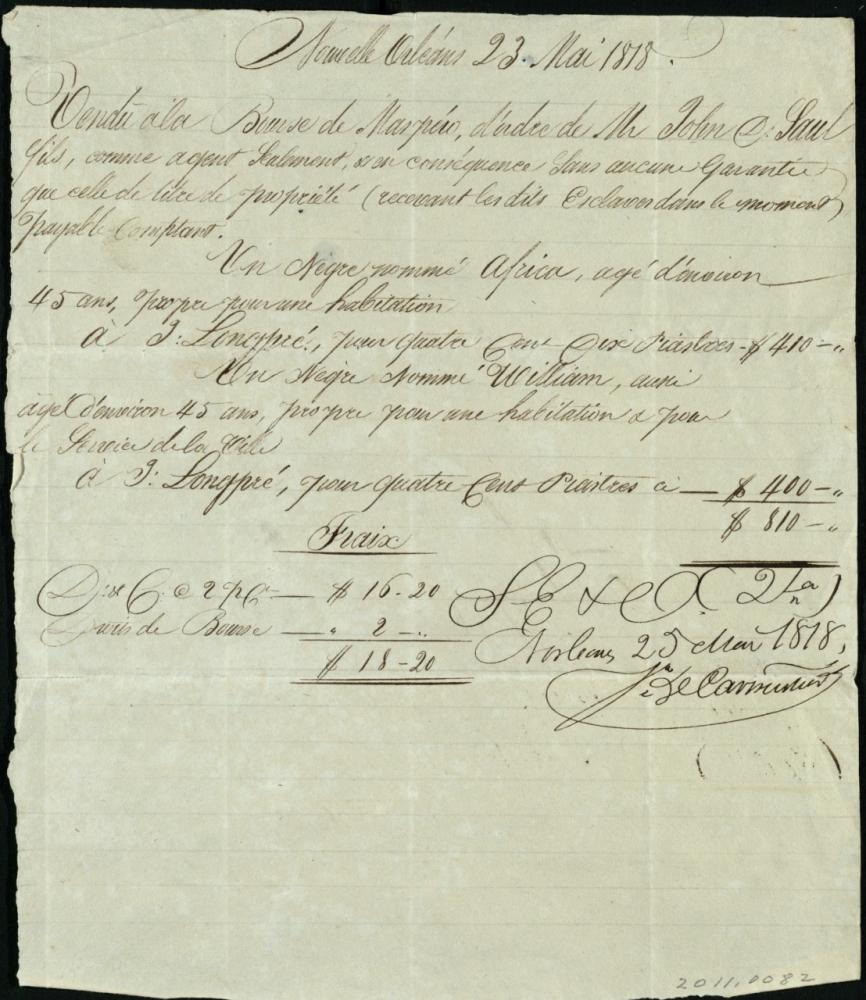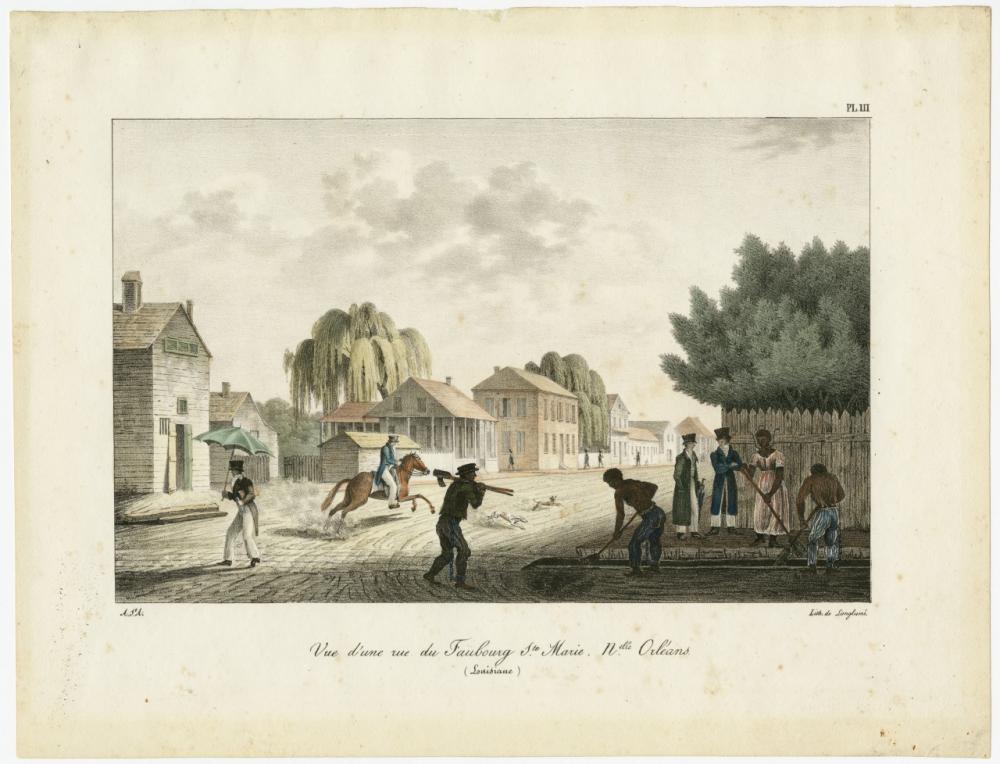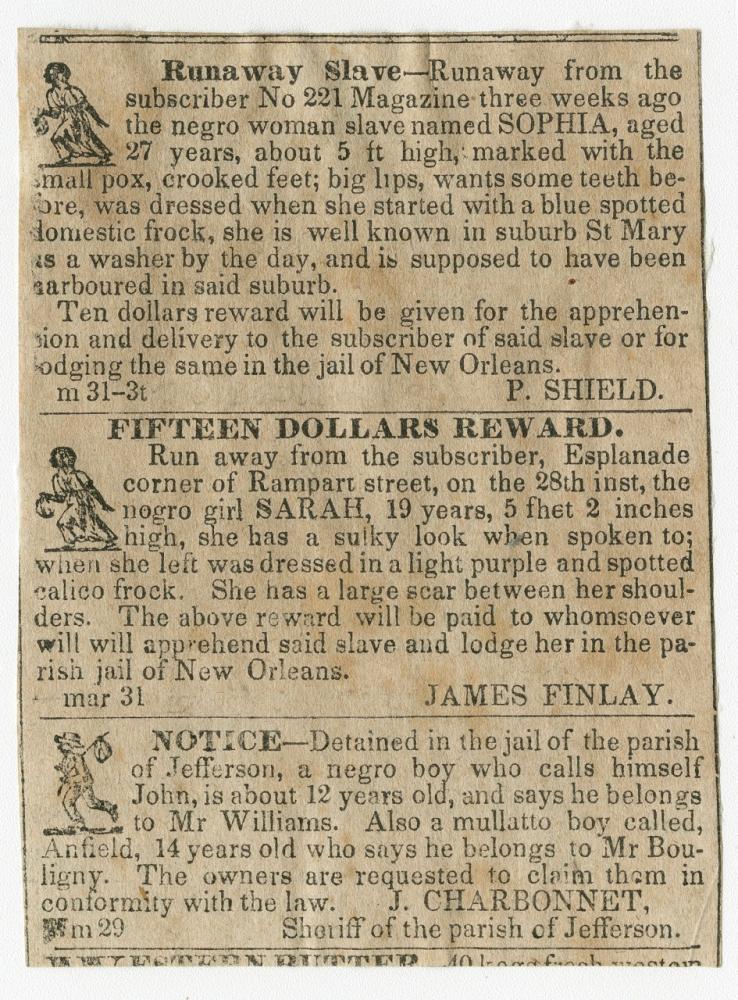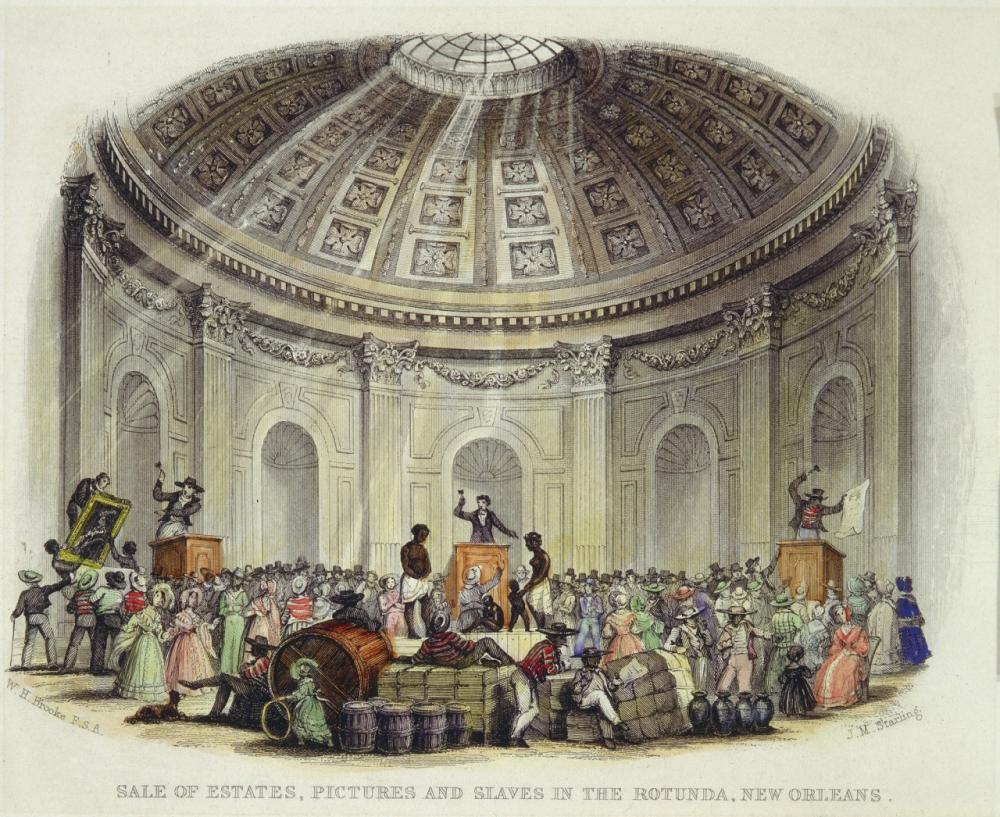From the colonial period and into statehood, slavery was a ubiquitous element of everyday life in New Orleans and Louisiana—affecting all parts of the local community, economy, and culture. The official end of the international slave trade, marked by the signing into law of An Act to Prohibit the Importation of Slaves on the second day of March 1807, dramatically altered the way slaves were bought and sold in the United States of America. In New Orleans, this meant an increase in sales of slaves brought to the city from the Upper South, and eventually the establishment of the city as a primary hub of the domestic slave trade.
The seven items included below are just a small selection of the materials in THNOC's holdings related to the 19th-century domestic slave trade in New Orleans.
Sale of Africa, aged 45, and William, aged 45, by John D. Saul to Jean Longpré
• During the antebellum period in New Orleans, slaves were bought and sold at many different locations and through many different types of transactions—including successions, individual sales, auctions, bankruptcy, and estate sales. • The United States' largest antebellum slave market, New Orleans was the initial destination for an estimated one million enslaved individuals, forced from bondage in the Upper South to the markets of New Orleans, to be sold and relocated once more to sites across the Lower South.
• This sale took place at Maspero’s Exchange, which was one of several trading places clustered around St. Louis and Chartres Streets in the French Quarter. These “coffee houses” were social gathering spaces where men could drink, gamble, lodge, and conduct business deals—including the buying and selling of enslaved humans.
• A primary component of the slave system, and specifically the slave trade, involved determining the monetary worth of individuals. Prices were assigned to individuals in acts of sale and advertisements—transforming the value of a person’s life into a dollar sum.
IMAGE CAPTION: Sale of Africa, aged 45, and William, aged 45, by John D. Saul to Jean Longpré; May 23, 1818; The Historic New Orleans Collection, 2011.0082
https://catalog.hnoc.org/web/arena/search#/entity/thnoc-archive/MSS%20627.2.1.2.5/receipt-for-%24-400-and-%24-410-paid-by-jean-longpre-for-the-purchase-of-2-enslaved-men-named-africa-and-william
RELATED ITEMS:
MSS 428.1 / Sale of Mary by Hopson O. Gentry to Edwin Brittin, June 7, 1839
MSS 430.2 / Sale of Alfred by James McGarvey to George W. Beeler, May 16, 1854
MSS 430.4 / Sale of Alfred by George W. Beeler to Thomas Egan, August 6, 1857
MSS 447.5 / Sale of Louis by Pierre Deverges to Henry Tete, May 25, 1836
Vue d’une Rue du Faubourg Ste. Marie, Nouvelle Orléans (View of a street in the Faubourg St. Mary, New Orleans)
• During the 1820s, approximately 155,000 slaves were forcibly relocated from the East and Upper South to the Lower South.
• As of 1840, New Orleans’s population included 23,448 enslaved persons (or slightly more than one fifth of the overall city’s population)—composing a portion of the city’s urban labor force. Here, three individuals are depicted maintaining the street around a property.
• Punishments for attempting to escape the brutal reality of slavery could be extremely harsh, and included whipping, branding, and maiming. Sometimes heavy iron collars—often including bells—were placed around the necks of runaways. An example of this type of collar can be seen on the enslaved woman on the right side of this lithograph. These collars served to both identify individuals as flight risks, and to limit their ability to attempt another escape.
IMAGE CAPTION: Vue d’une Rue du Faubourg Ste. Marie, Nouvelle Orléans (View of a street in the Faubourg St. Mary, New Orleans); ca. 1821; The Historic New Orleans Collection, 1937.2.3
RELATED ITEMS:
1975.93.1–.6 / Hauling the Whole Weeks Picking
Sale of Eliza, aged 18, and Charlotte, aged 14, by Christopher Toledano to Antoine Prudhomme
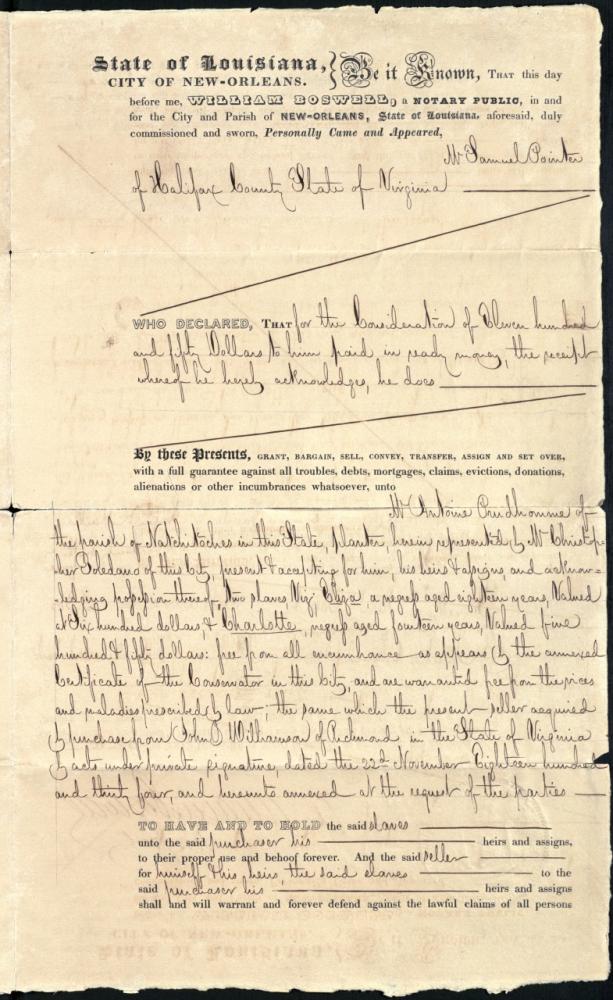
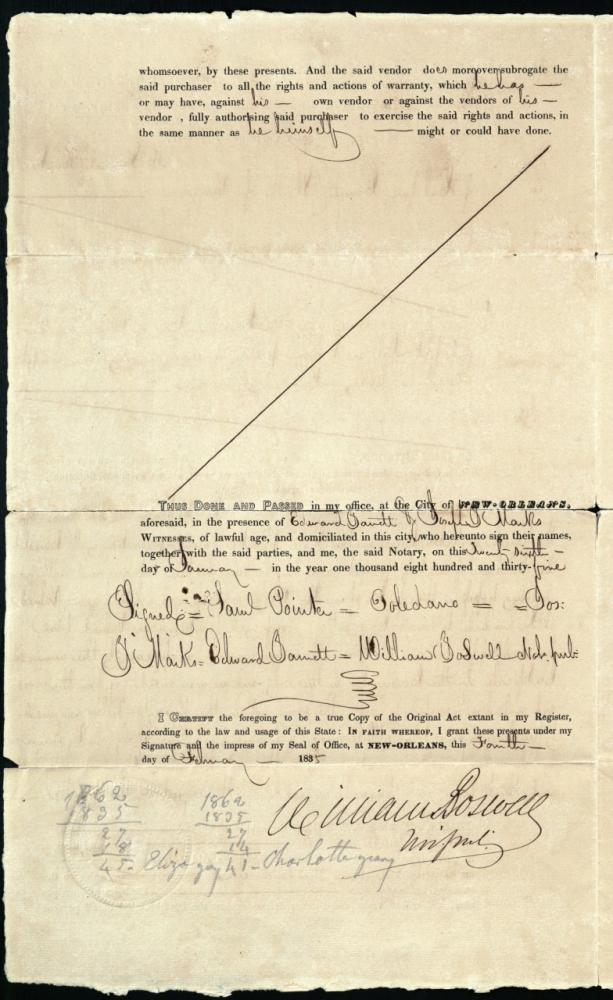
• During the 1830s approximately 288,000 slaves were relocated from the East and Upper South to the expanding Lower South.
• Being sold as property left slaves with incredible amounts of uncertainty and very limited agency; individuals could only speculate on the temperament of their new owners and had little control over who purchased them, where they were headed, and the type of work they would do.
• The system of slavery was complex and far reaching. Local and regional governments were complicit in the buying and selling of humans in bondage. Notaries licensed in the City of New Orleans and State of Louisiana—such as William Boswell, who executed the above document—were one of many professional groups, including bankers, clothiers, and medical professionals, who profited from the institution.
IMAGE CAPTION: Sale of Eliza, aged 18, and Charlotte, aged 14, by Christopher Toledano to Antoine Prudhomme; January 26, 1835; The Historic New Orleans Collection, 99-109-L MSS 595.7.26.2
RELATED ITEMS:
91-69-L / Sale of Joseph Turner, aged 21, by Hope Hull Slatter to Ursin Provost Jr. on April 5, 1847
2000-87-L / Sale of Silvia, aged 40, and Rose, aged 15, by Charles W. Allen to Ida Jarreau on April 17, 1858
Newspaper clipping showing two runaway slave notices and one notice of slaves being detained in prison to be retrieved by their masters
• During the antebellum period newspapers were littered with listings of runaway slaves. A typical advertisement included the physical description of the runaway, the last location in which he or she was spotted, and a reward for his or her recapture.
• Many attempted escapes were precipitated by acts of sale. Fear of the unknown circumstances of new masters, and the desire to return to home, friends, and family, often led individuals to choose the gamble of an attempted escape.
• While escape attempts were common, success was not. Multiple factors made escaping bondage exceptionally difficult. Enslaved people were frequently prevented from learning to read, slave patrols scoured the countryside looking for fugitives, and escapees often had to travel enormous distances to reach states where slavery was illegal in order to secure their freedom.
• Captured runaways were often held in jail until their owners were able to claim them.
IMAGE CAPTION: Newspaper clipping showing two runaway slave notices and one notice of slaves being detained in prison to be retrieved by their masters; April 2, 1836; The Historic New Orleans Collection, 1974.25.23.6.3
RELATED ITEMS:
1974.25.23.7 / Slave runaway and auction notices
Sale of Estates, Pictures and Slaves in the Rotunda, New Orleans
• During the 1840s approximately 189,000 enslaved people were relocated from the East and Upper South to the expanding Lower South.
• In antebellum New Orleans slaves were often sold at auction alongside dry goods, livestock, finished material goods, and any other conceivable piece of property. No distinction was made between human life and other types of property.
• Slave sales often took place in startlingly visible and high-profile locations, such as within the famed rotunda of the St. Louis Hotel, in the heart of the Vieux Carré, the site of today's Royal Orleans Hotel.
IMAGE CAPTION: Sale of Estates, Pictures and Slaves in the Rotunda, New Orleans; 1842; The Historic New Orleans Collection, 1974.25.23.4
RELATED ITEMS:
1941.3 / Slave Auction
1974.25.29.131 / Old Slave Block in St. Louis Hotel, New Orleans
1979.113 / A Slave Auction at the South
Auction notice for the sale of 178 slaves from Waverly and Meredith Plantations, part of the estate of William M. Lambeth
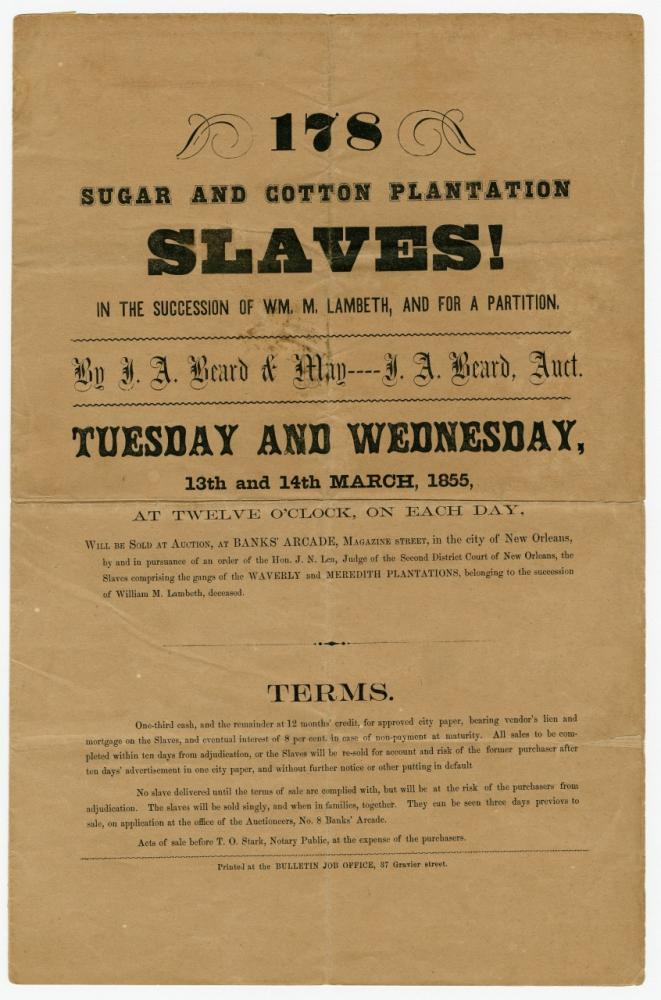

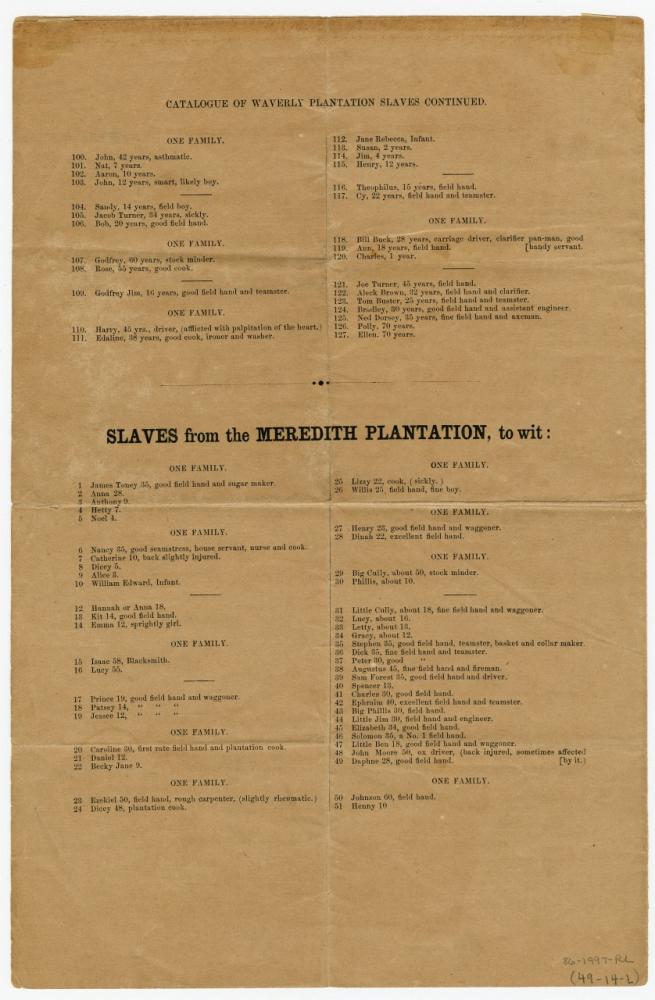
• During the 1850s, approximately 250,000 slaves are relocated from the East and Upper South to the expanding Lower South.
• Listed here as both families and individuals, enslaved persons were often sold independently of familial connections. As a result, severing of families through sale was not uncommon.
• Successions, such as the one shown above, often included the sale and forced relocation of an entire plantation’s workforce, which caused the destruction of multigenerational communities.
IMAGE CAPTION: Auction notice for the sale of 178 slaves from Waverly and Meredith Plantations, part of the estate of William M. Lambeth; 1855; The Historic New Orleans Collection, 86-1997-RL
RELATED ITEMS:
1974.25.23.6.2 / Slave auction to be held at Hewlett’s Exchange
2009.0061 / George W. Johnson Woodland Plantation correspondence
2009.0045.2 / Photograph of Evergreen Plantation slave cabins
73-701-L / Hewlett and Raspiller auction notice for the sale of twenty-four slaves from the Iberville Parish estate of Jonathan Erwin
A Slave-Pen at New Orleans—before the Auction
• Slavers took efforts to dress up—literally and figuratively—their valuable human merchandise. In the slave pens, while awaiting sale, enslaved people were typically forced to exercise and given increased rations, new clothing, and medical care, all designed to make them appear healthier and therefore increase their value. Toward this end, slaves were also given lessons in docility and agreeability.
• Slavers also used various techniques to alter the physical appearances of slaves prior to sale in hopes of recouping increased profits, including shaving beards, plucking gray hairs, blackening hair with dyes, adding tallow to girls’ hair, and greasing slaves’ faces—all to impart the notion of good health and youthfulness to prospective buyers.
• Slaves awaiting sale often received new names and fictitious backstories and were obliged, under threat of corporal punishment, to take part as actors in their own sale.
• In 1852 a measure was passed in the city’s 2nd Municipality forbidding the presentation of slaves on the sidewalks in front of the pens. Recognizing that the sale of human beings was uncomfortable to see, but unwilling to abolish the trade, city leaders instead chose to hide the hideousness of the slave market from the public eye.
• Printed in 1863 by the New York City–based Harper’s Weekly, the above depiction is identified as "A sketch of the past" and illustrates a slave sale prior to the enactment of the 1852 law, when slaves were often sold on the street.
IMAGE CAPTION: A Slave-Pen at New Orleans—before the Auction; January 24, 1863; The Historic New Orleans Collection, 1958.43.24
RELATED ITEMS:
1977.137.18.460 / Slavers
FOR FURTHER READING:
Johnson, Walter. Soul by Soul: Life Inside an Antebellum Slave Market. Cambridge: Harvard University Press, 1999.
Kramer, John Theophilus. The Slave Auction. Boston: Wallcut, 1859.
Northup, Solomon. Twelve Years a Slave. Baton Rouge: Louisiana State University Press, 1968.

